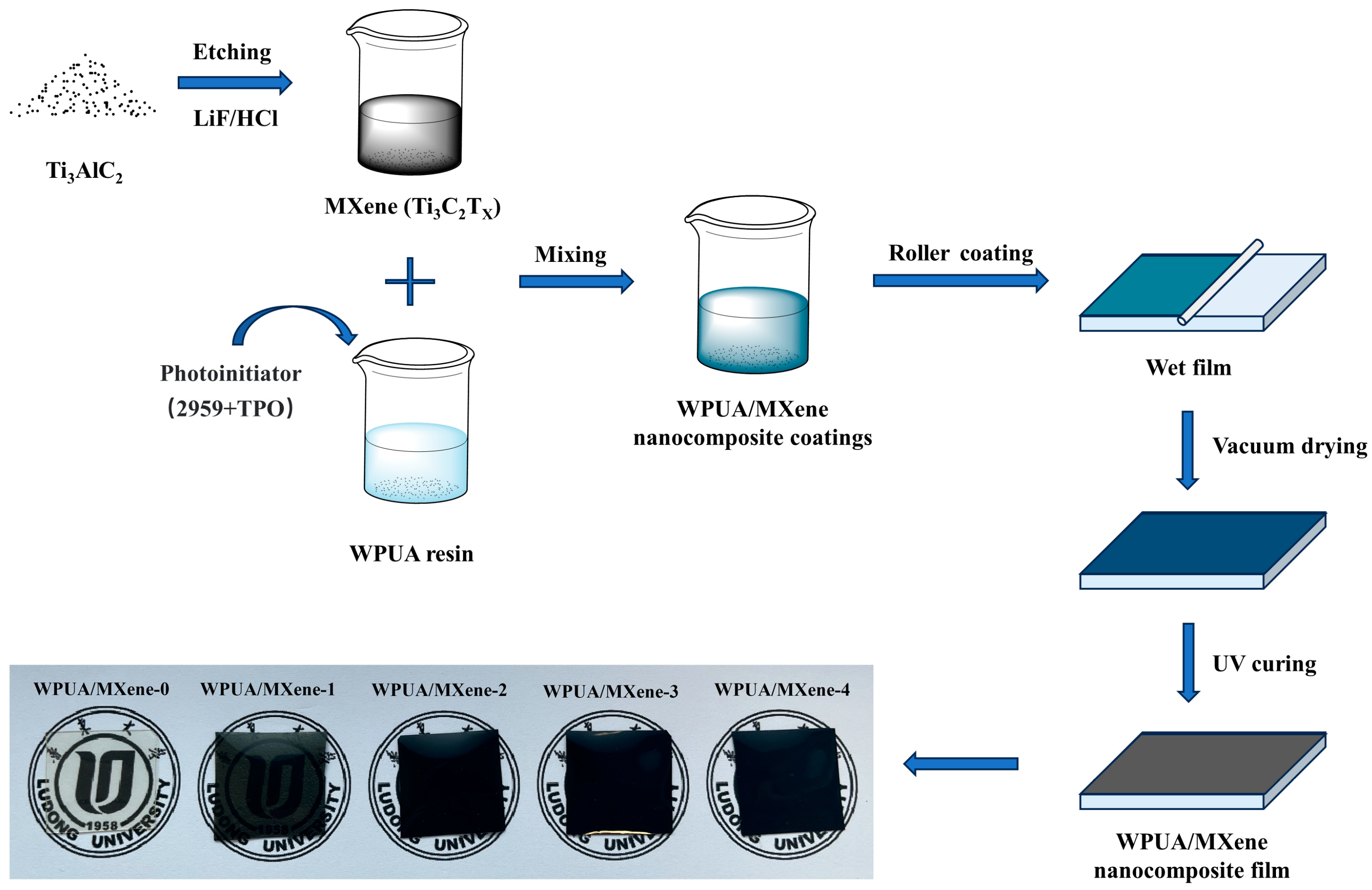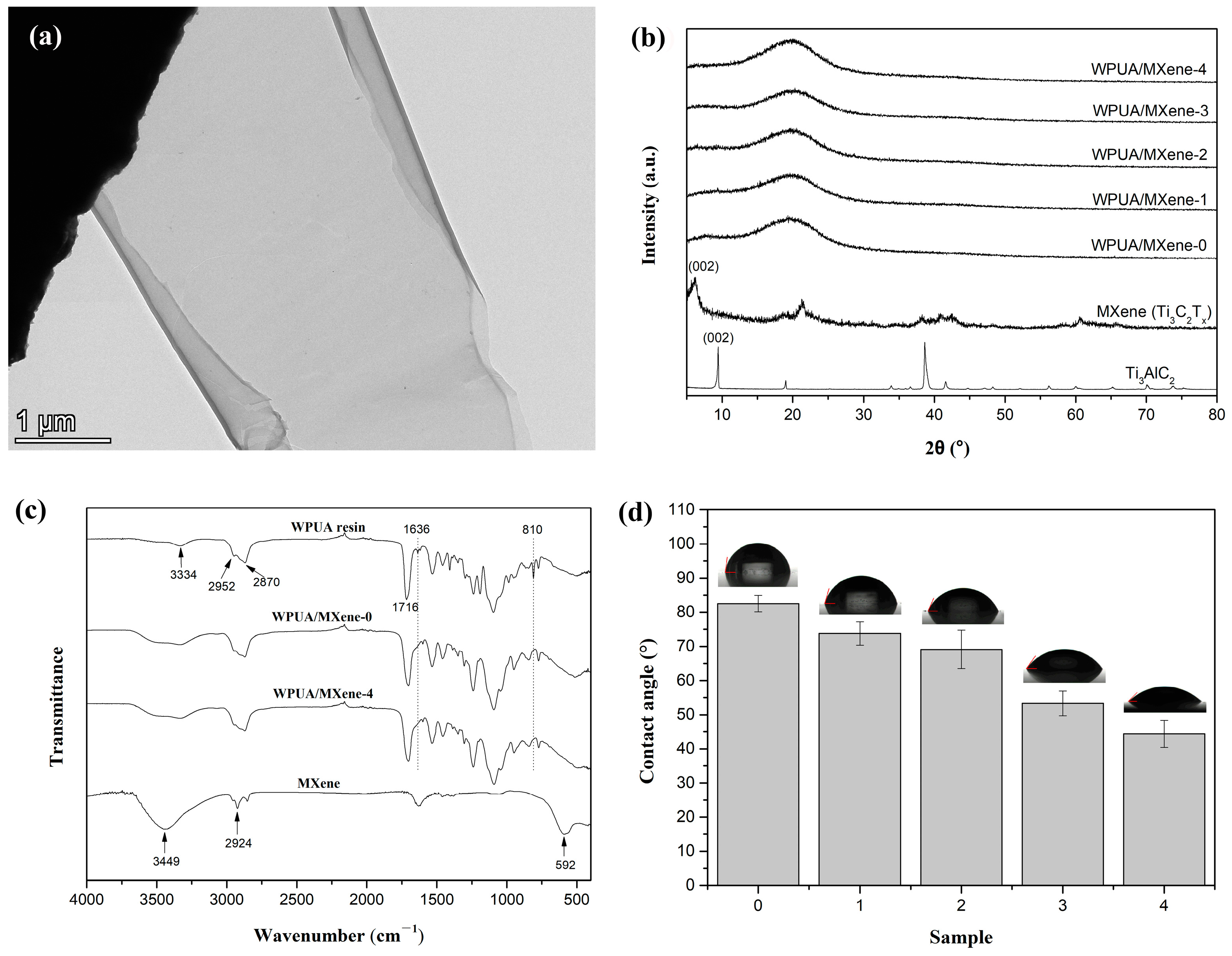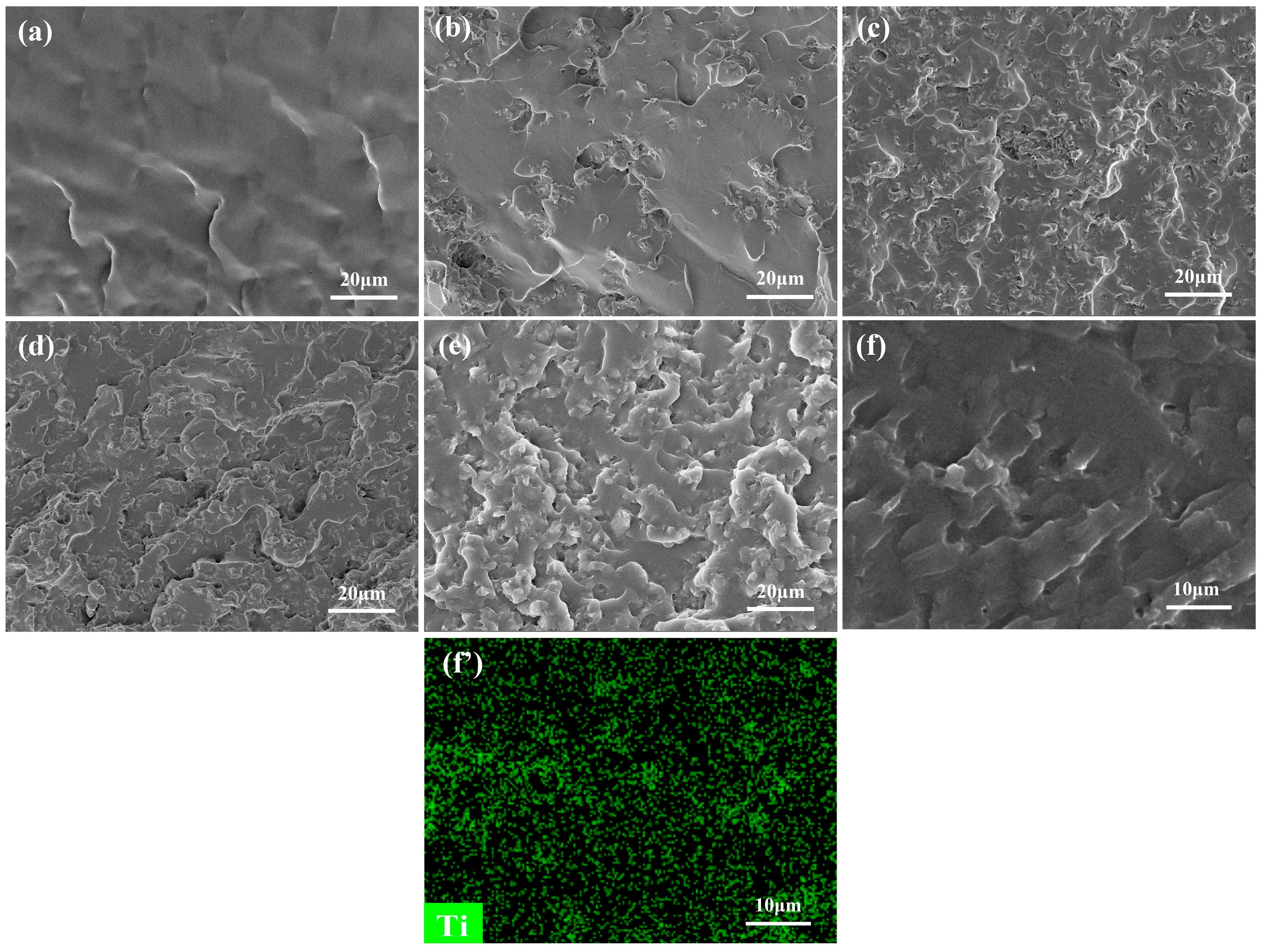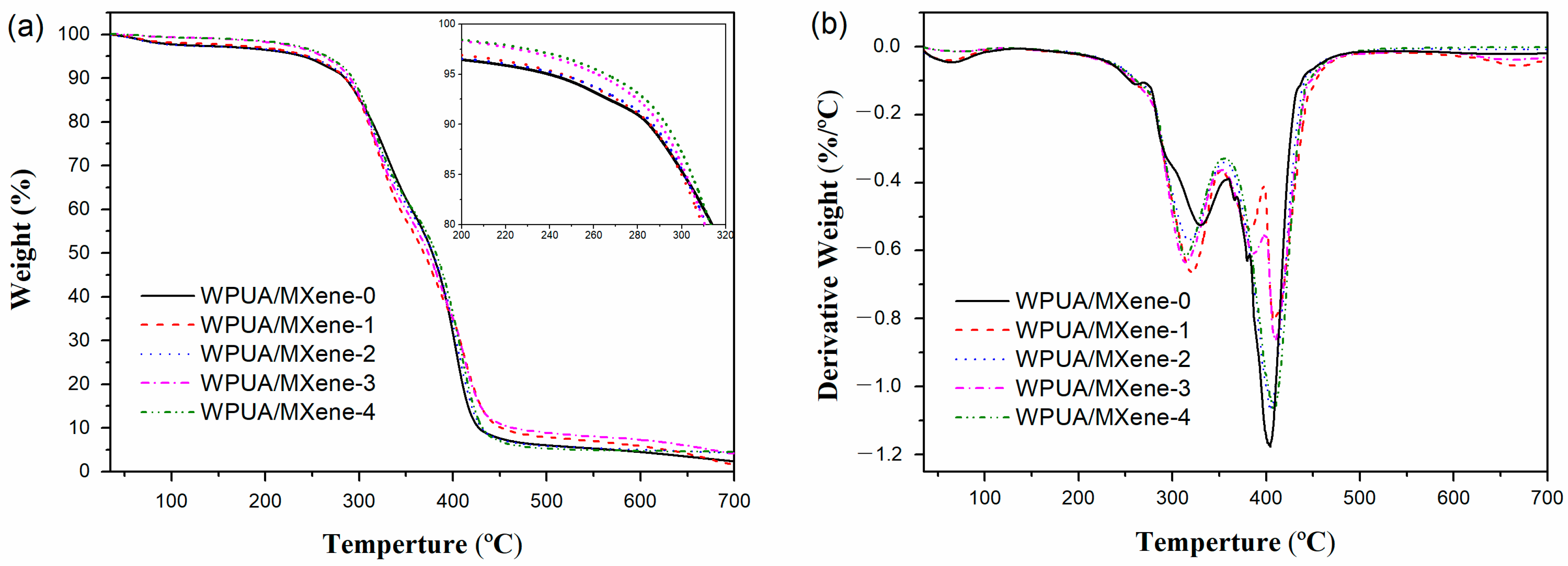Preparation and Properties of UV-Curable Waterborne Polyurethane Acrylate/MXene Nanocomposite Films
Abstract
:1. Introduction
2. Materials and Methods
2.1. Materials
2.2. Synthesis of MXene
2.3. Preparation of UV-Curable WPUA/MXene Nanocomposites
2.4. Characterization
3. Results and Discussion
3.1. Characterization of MXene
3.2. Characterization of WPUA/MXene Nanocomposite Films
3.3. Hydrophilicity of WPUA/MXene Nanocomposite Films
3.4. Mechanical Properties of WPUA/MXene Nanocomposite Films
3.5. Thermal Properties of WPUA/MXene Nanocomposite Films
4. Conclusions
Author Contributions
Funding
Data Availability Statement
Conflicts of Interest
References
- Lv, C.H.; Hu, L.; Yang, Y.; Li, H.B.; Huang, C.; Liu, X.H. Waterborne UV-curable polyurethane acrylate/silica nanocomposites for thermochromic coatings. Rsc Adv. 2015, 5, 25730–25737. [Google Scholar] [CrossRef]
- Chen, G.; Ouyang, S.; Deng, Y.Q.; Chen, M.X.; Zhao, Y.Q.; Zou, W.C.; Zhao, Q. Improvement of self-cleaning waterborne polyurethane-acrylate with cationic TiO2/reduced graphene oxide. Rsc Adv. 2019, 9, 18652–18662. [Google Scholar] [CrossRef] [PubMed]
- Wu, K.H.; Xiang, S.L.; Zhi, W.Q.; Bian, R.J.; Wang, C.C.; Cai, D.Y. Preparation and characterization of UV curable waterborne poly(urethane-acrylate)/antimony doped tin oxide thermal insulation coatings by sol-gel process. Prog. Org. Coat. 2017, 113, 39–46. [Google Scholar] [CrossRef]
- Dai, Y.T.; Qiu, F.X.; Xu, J.C.; Yu, Z.P.; Yang, P.F.; Xu, B.B.; Jiang, Y.; Yang, D.Y. Preparation and properties of UV-curable waterborne graphene oxide/polyurethane-acrylate composites. Plast. Rubber Compos. 2014, 43, 54–62. [Google Scholar] [CrossRef]
- Feng, J.; Ye, D. Polymerizable ZnO photoinitiators of surface modification with hydroxyl acrylates and photopolymerization with UV-curable waterborne polyurethane acrylates. Eur. Polym. J. 2019, 120, 109252. [Google Scholar] [CrossRef]
- Wang, X.; Hu, Y.; Song, L.; Xing, W.Y.; Lu, H.D.; Lv, P.; Jie, G.X. UV-curable waterborne polyurethane acrylate modified with octavinyl POSS for weatherable coating applications. J. Polym. Res. 2011, 18, 721–729. [Google Scholar] [CrossRef]
- Xu, J.C.; Jiang, Y.; Qiu, F.X.; Dai, Y.T.; Yang, D.Y.; Yu, Z.P.; Yang, P.F. Synthesis, mechanical properties and iron surface conservation behavior of UV-curable waterborne polyurethane-acrylate coating modified with inorganic carbonate. Polym. Bull. 2018, 75, 4713–4734. [Google Scholar] [CrossRef]
- Ran, W.; Lin, S.H.; Rempel, G.L.; Pan, Q.M. Synthesis and Properties of UV Curable Waterborne Polyurethane Acrylate Nanocomposite Films Based on the Surface Modification of gamma-Al2O3. Polym. Korea 2017, 41, 385–393. [Google Scholar] [CrossRef]
- Naguib, M.; Kurtoglu, M.; Presser, V.; Lu, J.; Niu, J.J.; Heon, M.; Hultman, L.; Gogotsi, Y.; Barsoum, M.W. Two-Dimensional Nanocrystals Produced by Exfoliation of Ti3AlC2. Adv. Mater. 2011, 23, 4248–4253. [Google Scholar] [CrossRef]
- Liu, L.; Ying, G.B.; Wen, D.; Zhang, K.C.; Hu, C.; Zheng, Y.T.; Zhang, C.; Wang, X.; Wang, C. Aqueous solution-processed MXene (Ti3C2Tx) for non-hydrophilic epoxy resin-based composites with enhanced mechanical and physical properties. Mater. Des. 2021, 197, 109276. [Google Scholar] [CrossRef]
- Feng, A.L.; Hou, T.Q.; Jia, Z.R.; Zhang, Y.; Zhang, F.; Wu, G.L. Preparation and Characterization of Epoxy Resin Filled with Ti3C2Tx MXene Nanosheets with Excellent Electric Conductivity. Nanomaterials 2020, 10, 162. [Google Scholar] [CrossRef] [PubMed]
- Wang, L.; Chen, L.X.; Song, P.; Liang, C.B.; Lu, Y.J.; Qiu, H.; Zhang, Y.L.; Kong, J.; Gu, J.W. Fabrication on the annealed Ti3C2Tx MXene/Epoxy nanocomposites for electromagnetic interference shielding application. Compos. Part. B Eng. 2019, 171, 111–118. [Google Scholar] [CrossRef]
- Li, Y.L.; Zhou, B.; Shen, Y.; He, C.G.; Wang, B.; Liu, C.T.; Feng, Y.Z.; Shen, C.Y. Scalable manufacturing of flexible, durable Ti3C2Tx MXene/Polyvinylidene fluoride film for multifunctional electromagnetic interference shielding and electro/photo-thermal conversion applications. Compos. Part. B Eng. 2021, 217, 108902. [Google Scholar] [CrossRef]
- Rajavel, K.; Luo, S.; Wan, Y.; Yu, X.; Hu, Y.; Zhu, P.; Sun, R.; Wong, C. 2D Ti3C2Tx MXene/polyvinylidene fluoride (PVDF) nanocomposites for attenuation of electromagnetic radiation with excellent heat dissipation. Compos. Part. A Appl. Sci. Manuf. 2020, 129, 105693. [Google Scholar] [CrossRef]
- Liu, Z.X.; Wang, W.Y.; Tan, J.J.; Liu, J.; Zhu, M.F.; Zhu, B.L.; Zhang, Q.Y. Bioinspired ultra-thin polyurethane/MXene nacre-like nanocomposite films with synergistic mechanical properties for electromagnetic interference shielding. J. Mater. Chem. C 2020, 8, 7170–7180. [Google Scholar] [CrossRef]
- Sheng, X.X.; Zhao, Y.F.; Zhang, L.; Lu, X. Properties of two-dimensional Ti3C2 MXene/thermoplastic polyurethane nanocomposites with effective reinforcement via melt blending. Compos. Sci. Technol. 2019, 181, 107710. [Google Scholar] [CrossRef]
- Yang, W.; Liu, J.J.; Wang, L.L.; Wang, W.; Yuen, A.C.Y.; Peng, S.H.; Yu, B.; Lu, H.D.; Yeoh, G.H.; Wang, C.H. Multifunctional MXene/natural rubber composite films with exceptional flexibility and durability. Compos. Part. B Eng. 2020, 188, 107875. [Google Scholar] [CrossRef]
- Li, M.K.; Sun, Y.Y.; Feng, D.Y.; Ruan, K.P.; Liu, X.; Gu, J.W. Thermally conductive polyvinyl alcohol composite films via introducing hetero-structured MXene@silver fillers. Nano Res. 2023, 16, 7820–7828. [Google Scholar] [CrossRef]
- Woo, J.H.; Kim, N.H.; Kim, S.I.; Park, O.K.; Lee, J.H. Effects of the addition of boric acid on the physical properties of MXene/polyvinyl alcohol (PVA) nanocomposite. Compos. Part B Eng. 2020, 199, 108205. [Google Scholar] [CrossRef]
- Yan, X.F.; Fang, J.; Gu, J.J.; Zhu, C.K.; Qi, D.M. Flame Retardancy, Thermal and Mechanical Properties of Novel Intumescent Flame Retardant/MXene/Poly(Vinyl Alcohol) Nanocomposites. Nanomaterials 2022, 12, 477. [Google Scholar] [CrossRef]
- Sun, R.; Zhang, H.B.; Liu, J.; Xie, X.; Yang, R.; Li, Y.; Hong, S.; Yu, Z.Z. Highly Conductive Transition Metal Carbide/Carbonitride(MXene)@polystyrene Nanocomposites Fabricated by Electrostatic Assembly for Highly Efficient Electromagnetic Interference Shielding. Adv. Funct. Mater. 2017, 27, 1702807. [Google Scholar] [CrossRef]
- Huang, Y.; Jiang, S.; Liang, R.; Sun, P.; Hai, Y.; Zhang, L. Thermal-triggered insulating fireproof layers: A novel fire-extinguishing MXene composites coating. Chem. Eng. J. 2020, 391, 123621. [Google Scholar] [CrossRef]
- ASTM D882-18; Standard Test Method for Tensile Properties of Thin Plastic Sheeting. ASTM International: West Conshohocken, PA, USA, 2018.
- Jin, X.; Wang, J.; Dai, L.; Liu, X.; Li, L.; Yang, Y.; Cao, Y.; Wang, W.; Wu, H.; Guo, S. Flame-retardant poly(vinyl alcohol)/MXene multilayered films with outstanding electromagnetic interference shielding and thermal conductive performances. Chem. Eng. J. 2020, 380, 122475. [Google Scholar] [CrossRef]
- Zhang, T.Y.; Wang, H.; Tong, J.M.; Zhang, J.G.; Wang, X.H.; Zeng, Y. High-efficiency ultraviolet shielding and high transparency of Ti3C2Tx MXene/poly(vinyl alcohol) nanocomposite films. Compos. Commun. 2022, 33, 101235. [Google Scholar] [CrossRef]
- Zhang, Y.; Wang, L.; Zhang, J.; Song, P.; Xiao, Z.; Liang, C.; Qiu, H.; Kong, J.; Gu, J. Fabrication and investigation on the ultra-thin and flexible Ti3C2Tx/co-doped polyaniline electromagnetic interference shielding composite films. Compos. Sci. Technol. 2019, 183, 107833. [Google Scholar] [CrossRef]
- Thirumal, V.; Yuvakkumar, R.; Kumar, P.S.; Keerthana, S.P.; Ravi, G.; Velauthapillai, D.; Saravanakumar, B. Efficient photocatalytic degradation of hazardous pollutants by homemade kitchen blender novel technique via 2D-material of few-layer MXene nanosheets. Chemosphere 2021, 281, 130984. [Google Scholar] [CrossRef]
- Pandey, R.P.; Rasheed, P.A.; Gomez, T.; Azam, R.S.; Mahmoud, K.A. A fouling-resistant mixed-matrix nanofiltration membrane based on covalently cross-linked Ti3C2TX (MXene)/cellulose acetate. J. Membr. Sci. 2020, 607, 118139. [Google Scholar] [CrossRef]
- Lu, J.; Zhang, Y.; Tao, Y.; Wang, B.; Cheng, W.; Jie, G.; Song, L.; Hu, Y. Self-healable castor oil-based waterborne polyurethane/MXene film with outstanding electromagnetic interference shielding effectiveness and excellent shape memory performance. J. Colloid Interface Sci. 2021, 588, 164–174. [Google Scholar] [CrossRef]
- Song, P.; Qiu, H.; Wang, L.; Liu, X.Y.; Zhang, Y.L.; Zhang, J.L.; Kong, J.; Gu, J.W. Honeycomb structural rGO-MXene/epoxy nanocomposites for superior electromagnetic interference shielding performance. Sustain. Mater. Technol. 2020, 24, e00153. [Google Scholar] [CrossRef]






| Sample | MXene Content/wt% | UV-Curable WPUA Mixture/g | MXene Solution/mL | H2O/mL |
|---|---|---|---|---|
| WPUA/MXene-0 | 0 | 30 | 0 | 20 |
| WPUA/MXene-1 | 0.077 | 30 | 5 | 15 |
| WPUA/MXene-2 | 0.154 | 30 | 10 | 10 |
| WPUA/MXene-3 | 0.231 | 30 | 15 | 5 |
| WPUA/MXene-4 | 0.308 | 30 | 20 | 0 |
| Sample | Tg (°C) | T5% (°C) | Tmax1 (°C) | Tmax2 (°C) |
|---|---|---|---|---|
| WPUA/MXene-0 | −24.9 | 239.6 | 329.7 | 404.3 |
| WPUA/MXene-1 | −24.3 | 245.6 | 320.8 | 407.6 |
| WPUA/MXene-2 | −27.7 | 244.2 | 318.3 | 406.1 |
| WPUA/MXene-3 | −28.9 | 261.6 | 314.6 | 409.8 |
| WPUA/MXene-4 | −26.0 | 265.8 | 313.8 | 408.6 |
Disclaimer/Publisher’s Note: The statements, opinions and data contained in all publications are solely those of the individual author(s) and contributor(s) and not of MDPI and/or the editor(s). MDPI and/or the editor(s) disclaim responsibility for any injury to people or property resulting from any ideas, methods, instructions or products referred to in the content. |
© 2023 by the authors. Licensee MDPI, Basel, Switzerland. This article is an open access article distributed under the terms and conditions of the Creative Commons Attribution (CC BY) license (https://creativecommons.org/licenses/by/4.0/).
Share and Cite
Wang, Y.; Zhang, S.; Lin, Y.; Wang, Q.; Zhang, Y.; Sun, C.; Qu, R. Preparation and Properties of UV-Curable Waterborne Polyurethane Acrylate/MXene Nanocomposite Films. Nanomaterials 2023, 13, 3022. https://doi.org/10.3390/nano13233022
Wang Y, Zhang S, Lin Y, Wang Q, Zhang Y, Sun C, Qu R. Preparation and Properties of UV-Curable Waterborne Polyurethane Acrylate/MXene Nanocomposite Films. Nanomaterials. 2023; 13(23):3022. https://doi.org/10.3390/nano13233022
Chicago/Turabian StyleWang, Ying, Shuai Zhang, Yanli Lin, Qianyi Wang, Ying Zhang, Changmei Sun, and Rongjun Qu. 2023. "Preparation and Properties of UV-Curable Waterborne Polyurethane Acrylate/MXene Nanocomposite Films" Nanomaterials 13, no. 23: 3022. https://doi.org/10.3390/nano13233022
APA StyleWang, Y., Zhang, S., Lin, Y., Wang, Q., Zhang, Y., Sun, C., & Qu, R. (2023). Preparation and Properties of UV-Curable Waterborne Polyurethane Acrylate/MXene Nanocomposite Films. Nanomaterials, 13(23), 3022. https://doi.org/10.3390/nano13233022





